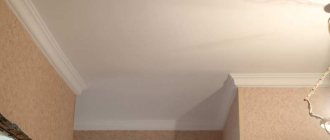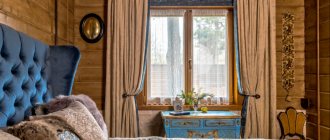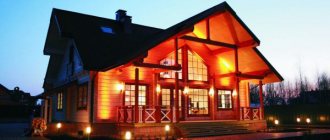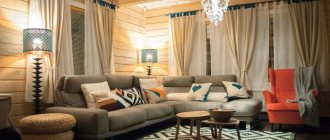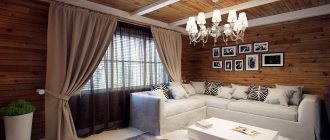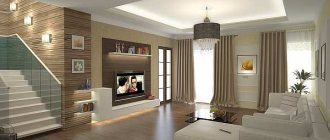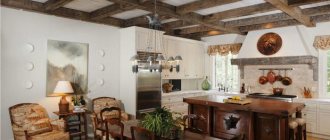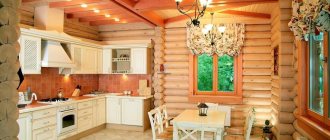What should be the ceiling materials in wooden houses?
Ceiling systems in wooden buildings have structural specificity. You need to choose in advance how to make the ceiling in the house, what materials to use. Most often we are talking about light beam floors and plank flooring. To fill the distance between the beams, special insulation is used.
When choosing what can be used to sheathe the ceilings in a wooden house, you should take into account the following wishes for its characteristics:
- Light weight, good insulation and sound insulation characteristics.
- Safety. The ceiling finish must be durable, reliable and fire resistant. It should not contain harmful toxins.
- Durability. The long service life of the ceiling system will make it possible to forget about repairs for a long time.
- Aesthetics. It is recommended to select a finish that matches the design of the walls. In this case, you can achieve unity of style, which will help create comfort and attractiveness.
Most often, natural materials are used in wooden houses to promote good air circulation inside the ceiling finish. It is very important that the design fits well into the overall style of the room’s decoration.
Requirements for materials for finishing wooden ceilings in a private house
The construction of floors in a country house is most often carried out using beams or beams on which rough flooring is laid. The space between the beams is filled with heat-insulating materials, and the ceiling is hemmed underneath. The design is significantly different from reinforced concrete floors in apartments, so the technology for performing the work and the functionality of the ceiling will be different.
The finishing material must meet the following criteria:
- ensuring heat and sound insulation - maintaining heat and a comfortable indoor microclimate is one of the main tasks when building a country house;
- aesthetic appearance - the ceiling is the most open surface and its design has a significant impact on the perception of the stylistic design of the room;
- durability – maximum service life will eliminate the need for frequent repairs;
- safety – it is necessary to ensure the reliability of the design;
- environmental friendliness - the very essence of a wooden house is the use of environmentally friendly materials that do not emit substances harmful to human health.
It is also worth noting one very important feature of new wooden houses - for some time after construction they are subject to settlement. Moreover, this process can take several months, and even years. Therefore, when choosing a finishing material for the ceiling, it is worth considering the fact that over time it may undergo deformation.
Preparatory activities
Before installing the selected ceiling system, the surface of the ceiling is impregnated with special antiseptic liquids. If there is consistently high humidity in the room (bathroom, kitchen, bathhouse), additional treatment with a waterproofing agent is carried out. It is important to provide fire protection to the surface. For these purposes, special impregnations containing fire retardants are used.
Wooden ceiling cladding is processed in the same way. This allows you to significantly extend the life of the elements and protect them from possible deformation. Before installing the sheathing, thermal insulation of the ceiling is carried out. For these purposes, it is allowed to use any insulation. They can be installed under a decorative surface or in the attic. During the preparation process, wiring and other communications are laid.
Choosing material
Particular attention should be paid to the choice of material for finishing the ceiling in a wooden house with beams. It is this that determines not only the design features of the room, but also the level of functionality, reliability and durability of a wooden ceiling with beams. Light beam structures with plank flooring are optimal for finishing a wooden house.
The space between the beams will need to be filled with a thermal insulation layer.
Let us dwell on the key requirements that apply to materials for finishing the ceiling in a wooden house with beams.
- Ecological cleanliness. Wood is an environmentally friendly natural material. And it will not release toxic compounds into the air even with sudden temperature changes or jumps in humidity levels.
- Reliability. Such structures are durable. They are really strong and can withstand negative mechanical impacts.
- Creating a harmonious interior. You can find a good ratio of artificial and natural finishing panels and coatings.
- Durability. When a wooden ceiling with beams is made with high quality, the finishing is carried out in compliance with all technological requirements, the coating can last for many years. In this case, there will be no need to repair the ceiling, it will look decent and will not lose its original characteristics.
- Low flammability level. Even when exposed to an open flame, a wooden ceiling in a house with beams will not easily ignite. It should be understood that the material requires additional treatment with appropriate fire retardants.
Natural wood is able to retain moisture well; it maintains an optimal indoor microclimate. At the same time, we also cannot forget about insulation: in a wooden house, it is high-quality insulation materials that become the key to comfort.
The ceiling beams in a wooden house don’t even need to be disguised in any way, because in a cottage they fit perfectly into the overall style of decoration, set a kind of “rustic” vector, and signal harmony with nature.
It's time to take a closer look at the various material options for reliable ceiling finishing in a wooden house with beams.
Multilayer plywood
This method of finishing the ceiling in a wooden house with beams cannot be called modern, as it slightly limits the designers’ imagination. But at the same time, many owners are attracted by the efficiency of using this material. It ensures the cost-effectiveness of the project and allows you to minimize the cost of finishing the ceiling in a wooden house with beams. The owners select high-quality multi-layer plywood from natural veneer. The installation process is simplified, since the weight of the plates is relatively small, but the area is impressive. It is also possible to create complex curved shapes. In addition, some people prefer to disguise beams and all kinds of communications with just such ceiling systems.
Plywood decorated to look like wood
It is advisable to distinguish between types of plywood. Let's look at the basic varieties.
- Moisture resistance level. This parameter must be taken into account in a wooden house with beams when finishing, if it is not heated in winter.
- Grade. There are five main varieties of multi-layer plywood. The third or fourth grade is quite suitable for decorating the ceiling.
- Type of topcoat. A decorative layer is provided. It is most often made from maple veneer, alder, and also birch. There is also an inner layer of spruce and pine.
- Appearance. Some owners prefer designer finishing options in a wooden house with beams with decorative patterns. In this case, the top layer imitates stone or plastic, wood.
- The degree of processing of the plywood plays a decisive role. Sanded is necessary for finishing, but untreated sheets are used for rough cladding.
To sheathe the ceiling in a wooden house with plywood beams, you will first need to install a reliable sheathing of slats. Difficulties can arise with the design of curved surfaces, so sometimes craftsmen prefer to also use plasterboard elements in designs.
Plywood is a good option for finishing ceilings; it allows you to carry out high-quality repairs at minimal cost.
Veneer
The finishing material should be distinguished from standard lining. It has a top layer of fairly thin veneer. The wood used here is valuable and expensive. Oak and rosewood veneers are in demand on the market. The panels have a width in the range of 15 - 200 cm. The finished ceiling is assembled from plates 20 - 90 cm.
Ceiling trim with wood veneer
The decorative top layer is glued to the natural wood base strips. In this case, exclusively reliable, safe adhesives are used. They do not harm the environment and do not emit toxic chemical compounds at high humidity levels or in extreme temperatures.
It is important to provide for all the main points in order to maximize the life of the finish in a wooden house with beams. Thus, it is recommended to impregnate the panels with special compounds for reliable protection against the negative effects of insects and microorganisms.
The price of veneer will definitely be higher than that of conventional lining. But the level of practicality and aesthetics is also greater here. Installation is simple, reliable, creates a good microclimate and sound insulation.
Lining
Environmentally friendly, attractive, modern - this material remains one of the most popular. When the ceiling in a wooden house with beams is covered with clapboard, it looks not only aesthetically pleasing, but also modern and fits perfectly into the overall style. It is quite possible to use inexpensive types of wood to reduce the renovation budget. In addition, a significant advantage of lining is reliable, efficient installation. It is possible to fasten the planks with high quality thanks to the special tongue-and-groove locking system provided during the manufacture of the lining.
Interior with clapboard ceiling
Undoubtedly, when choosing lining, knowledge about its classification will be useful to you.
- Extra. Such panels have almost ideal technical characteristics. The surface is smooth, carefully polished. There are no darkenings, depressions, marks of knots or bulges on it. The color is also uniform, the shade is deep.
- Class A, B. The lining may have minor visual defects. However, they do not in any way affect the technical characteristics or strength. Externally, a ceiling with such cladding will also look decent. Only upon closer inspection can you notice small disadvantages.
- Class C. This option is optimal for budget repairs and will help you save a lot. The presence of unevenness and knots is acceptable. But their number is also strictly limited. The finish still looks aesthetically pleasing.
- It is advisable to choose eurolining with water-repellent properties. Then it will be suitable for lining the flow in the kitchen and bathroom.
The lining attracts demanding customers with its durability and strength. At the same time, it provides a fairly good level of sound insulation. There is air exchange due to micropores, which creates a comfortable microclimate in the room of a wooden house with beams.
The designers note an interesting point. Natural cladding looks especially attractive in relatively small spaces. If the room is very spacious, sophistication and individuality are lost, and the feeling of comfort is no longer so obvious.
A good solution is to combine lining and other types of finishing materials. For example, you can sheathe the ceiling in a wooden house with beams as follows: line the purlins with dark panels, but fill the space between them with lighter panels. Visually, such a project will even allow you to slightly expand the room.
Natural massif
An expensive option for finishing the ceiling in a wooden house with beams. But such material looks luxurious and allows you to make the interior noble and non-trivial. Undoubtedly, this option is chosen by owners who strive to achieve a certain result precisely from a design point of view. At the same time, the performance properties of solid natural wood are also excellent.
The ceiling made of natural solid wood in a wooden house with beams attracts with its strength. It is durable, remains smooth, aesthetically pleasing for a long time, and is not subject to deformation. During the installation process, using such material is also very convenient, because the connection is made using tenons and grooves.
There is another significant advantage, which is noted by many experts and owners of houses with such finishing. It is the finishing of the ceiling with panels made of natural solid wood that allows you to create a particularly comfortable microclimate in the room.
Of course, the panels are quite expensive. But some people prefer to make prefabricated ceiling structures. They combine natural solid wood panels with cheaper materials. As a result, the surface looks original.
Block house: to be or not to be?
It is interesting that many are not even aware of this possibility: yes, the ceiling in a wooden house can be sheathed in block houses, although it is more often used for finishing facades. But such a design solution has its own specifics that must be taken into account.
Block house in interior decoration
Let us note several significant points.
- Together with the finishing layer, the lathing will take about 10 cm. And this is important to take into account, since the ceiling height will be significantly reduced.
- It is advisable to choose a block house to decorate rooms with ceilings of at least 2.7 m.
- You cannot install the panels without first installing the sheathing, since this material is in dire need of a ventilation gap.
- Since the front layer perfectly imitates a natural log, the result is an attractive effect: visually it seems that the ceiling is made of rounded logs.
- The weight of the material is quite large. And the supporting beams in the floors must be strong. Then they will definitely withstand the loads and guarantee safety.
- Experts recommend coating the surface of such a ceiling with varnish in order to reliably protect it from rotting and the negative effects of microorganisms.
A block house is a good solution for creating that very rustic style in a room that can be so attractive and memorable.
Plastic
This is a budget option, but it is also quite possible to create a catchy design and a cozy atmosphere. Polymer plates are made using two base layers, between which special stiffeners are necessarily provided. Installation is carried out quickly and without problems, since it is performed with a tongue-and-groove locking connection. The owners themselves can easily handle the installation of such finishing if they have basic skills.
Plastic in the ceiling with beams
Let us indicate the features of plastic.
- Optimal parameters allow for quick installation of the ceiling structure.
- Modern hardware stores have an impressive selection of such plastic panels. You can choose the best options for yourself in terms of size, visual features, and shades. A wide scope opens up for the implementation of the most daring design ideas.
- This finish is very convenient and practical to use. It does not collect dust or dirt and is very easy to clean with a damp sponge.
- Plastic is not afraid of excessively high humidity; it is invulnerable to microorganisms and insects.
- High-quality panels are absolutely safe. They do not release toxic substances into the air.
- The surface is perfectly flat. Plastic can be glossy or matte. A specific option is selected depending on the characteristics of the corresponding project. But now they are increasingly choosing a matte finish: it looks more noble, and glare and shine do not tire the eyes.
This cladding becomes even more attractive if you use plastic with decorative patterns. Let’s say the panels reliably imitate wood, silk, and natural stone.
Features of finishing materials
When choosing a suitable option for covering a wooden ceiling, not only quality and cost are taken into account, but also compliance with the overall design style of the room. In some cases, additional sheathing is not used at all (the insulating layer is laid on the attic side). Thanks to the open beams on the ceiling surface, you can create an original country house style (the so-called “country” style).
Sometimes the parameters of the timber or logs used in the construction of a home are such that it is possible to do without additional thermal insulation. Wood is characterized by the presence of such specific qualities as the ability to absorb excess moisture. Its release occurs when the air becomes too dry. Wood is a good insulator and provides good noise protection.
Most often, lumber, supplemented with plywood, lining, veneer panels or solid wood, is used as ceiling finishing in wooden houses. In the case of external insulation of the walls of the house, their surface is hidden by the finishing. In cases where it is not designed to look like wood, the ceiling can be decorated with plastic, plasterboard or suspended ceilings.
Floor and ceiling structures in a wooden house
The finishing is mounted on a rough base, which is attached to horizontal load-bearing structures. Wooden beams, in addition to supporting ones, can serve a decorative function. They can be sewn up or decorated beautifully, making them a room decoration. Open beams are appropriate in urban, country, and ethnic styles.
Three types of ceiling structures are suitable for wooden houses.
false ceiling
Installation begins with laying a vapor barrier on the floor beams. The film is overlapped, nailed with staples, and the seams are glued with waterproof tape. Sheet boards and chipboard are mounted on top of the vapor barrier membrane. The materials are joined on the floor beams, leaving a compensation gap of 5 mm. The wooden lining is hemmed onto a pre-assembled frame. On the attic side, between the floor beams, insulation is laid on the vapor barrier and covered with film on top. Then the attic floor is laid. If the beams will be a decorative element, the boards are placed on top and secured with self-tapping screws.
Flat ceiling
This option is suitable for small rooms and utility rooms with a distance between main walls of up to 2.5 meters. The boards are fixed to load-bearing walls or to slats nailed around the perimeter of the room. If the beams are open, they are sanded, treated with wax and drying oil. From the attic side, a vapor barrier film is laid on the plank base and insulated with rolled or bulk materials. The insulation is protected from moisture by a layer of insulation.
Panel ceiling
The structure consists of individual panels, which are assembled on the ground, lifted, and mounted on supporting beams.
Stages of panel assembly:
- two beams are placed parallel at a distance of 0.5 m, the edges rest against the rail;
- boards 0.6 m long are screwed or nailed in the transverse direction;
- the panel resembling a box is turned over and lined with a vapor barrier film;
- lay insulation and cover with waterproofing;
- the panels are lifted to the installation site.
The panels are heavy, so to facilitate transportation upstairs and installation, insulation work can be done in the attic. To eliminate cold bridges, the space between the panels is filled with insulation, for example, felt with foil. Along the entire length of the room, boards are placed on the shields and nailed to each block.
To give the panel rigidity, before raising it to a height, oblique jumpers are installed, which are then removed.
Lining
This material for finishing the ceiling in a log house is lightweight and environmentally friendly. This finish goes well with the walls of a wooden house. To reduce the cost of purchasing material, you can choose lining made from inexpensive wood. Installation of lamellas is facilitated by longitudinal tongues and grooves on the end faces.
Classification of lining:
- Extra. The most suitable material for sewing up the ceiling in the house. Expensive wood is used as a manufacturing material.
- A and B. There may be minor imperfections in the finish. This does not in any way reduce the strength characteristics of the material.
- C. Budget option, for the manufacture of which inexpensive wood species are used. The finishing surface contains flaws and a large number of knots.
What styles are natural wood used in?
Wood as a finishing material has been used all over the world for quite a long time. Reliability, aesthetics and elegant design allow it to be used in various interior design styles.
The main styles include the following:
- High tech;
- Country;
- Modern;
- Chalet;
- Eco style;
- Japanese style.
High-tech style
The high-tech style is characterized by a clearly defined geometry of objects, but despite this they should not have strict boundaries.
The presence of wood in a high-tech style looks quite urban
Country style
It’s hard to imagine a country-style room without using wood as a finishing touch, and the ceilings are no exception. The finishing material can be either lining or wooden panels, boards or wooden wallpaper.
Natural stone will add elegance and respectability to the interior
A well-chosen color combination of the ceiling and walls, combined with a fireplace, will give the room a truly homely feel.
A snow-white bedroom with wide spacious windows looks simply magnificent
Art Nouveau style
The main task of this style is to combine together different types of materials, natural and artificial. The use of wood is a fundamental component of room design; it can be used on the floor, ceiling and walls. The main thing is that it does not disturb the overall harmony of the interior.
A modern kitchen will always be relevant
Beautiful wide lining with a varnished surface
It will also always be appropriate to use various wooden structures on the ceiling that will harmoniously complement the interior.
An elegant wooden structure on the ceiling will dilute its monotonous surface
Chalet style
This style migrated to Russia from distant Switzerland and France. It would seem that the usual simplicity of the design of wooden houses should have gone unnoticed, but as it turned out, this is not at all the case. The grandeur and beauty of the “chalet” style can charm any connoisseur of beauty.
The predominant tones for this style are: brown, burgundy, dark green and red. It is necessary to use brighter colors with extreme caution so as not to disturb the overall atmosphere of the interior, since the “chalet” style loves natural tones.
Wonderful chalet style interior with beautiful views of nature
Living room decorated in chalet style
Bedroom with chalet style interior with wooden ceiling and hanging beams
Eco style
Eco is a derivative of the word ecology. From here it is not difficult to understand that the eco style provides for finishing only environmentally friendly material created by nature itself.
However, the use of natural materials is not one of the most important conditions for this style; it is very important to preserve their original appearance and appearance. The texture of the wood should be clearly visible, and its color palette should be as close to natural as possible.
Interior design of a country house in eco style
Unfortunately, it is impossible to ensure that wood processing does not involve harmful substances and that their cost does not increase. Wood treated with environmentally friendly impregnations will not be cheap, but believe me, it’s worth it, in return you will get crystal clear air in your home and a feeling of complete solitude with nature.
The use of other natural materials, such as gypsum decorative tiles, is also encouraged.
Floor-to-ceiling windows, a fireplace, a wall lined with decorative bricks, a wonderful sofa with a coffee table are the perfect combination for creating a truly cozy atmosphere in the house
Eco design loves space and good lighting. It is problematic to make the most of all the possibilities of this style in an apartment; a large country house with high ceilings and spacious rooms is perfect for these purposes. Only here you can truly give free rein to your imagination.
It is important to remember that eco style requires good lighting
Wooden ceilings will look good not only in the house, but also in other outbuildings. One style will allow you to avoid sharp boundaries between different zones.
An open terrace of a country house, decorated in the same style as the house, will be an excellent complement to modern design in eco style
Veneered panels
A material very similar to lining. The difference concerns the use of inexpensive wood for the manufacture of panels, which is covered with a thin veneer of expensive species on top. This allows you to imitate the luxury finish of a wooden ceiling in a private house. The dimensions of veneered panels differ from the lining.
Popular materials
Plywood sheets. One of the most economical materials can be called layers of plywood. For its manufacture, high quality veneer is taken.
Plywood is a very light material. You can cover the ceiling with it without any problems in a short period of time.
Lining
By carriage we mean boards of a special shape, where one side is sharpened, and the other side comes with a notch. Based on the installation principle, it is somewhat reminiscent of a construction set.
Moreover, such material is an environmentally friendly type of raw material, which largely explains its popularity.
Lining, like plywood, does not have much weight, the installation process is quick and easy.
Conventionally, lining can be divided into several categories:
- Extra: This is the highest grade material. It undergoes high-quality processing, and therefore is free from irregularities.
- A and B: about this category we can only say that its quality is slightly worse, but the presence of small irregularities does not affect the strength characteristics.
- C: the most budget choice. In principle, the price is directly proportional to the processing and quality characteristics. Cheap wood is selected as raw material.
Veneered panels
In some ways they resemble clapboards. However, it is still not the same thing. The manufacturing technology is similar, however, unlike lining, cheap wood is used here.
It is covered with a thin layer (the so-called veneer) of expensive wood. And, ultimately, you get something similar to lining, but more budget-friendly.
Solid wood
They are made exclusively from very expensive breeds. Consequently, their quality is at the highest level. Service life can exceed a period of several decades.
This material looks quite solid.
Plastic panels
Plastic panels provide an affordable, practical finish. Installation of such material does not take much time. Moreover, they need to be treated with a large number of special protective agents. If necessary, they can be very easily replaced.
Stretch ceiling
The material used for the ceiling in the house is PVC film or fabric without seams. Stretch ceilings are convenient because even if a wooden house shrinks, they retain their configuration. However, if the stretch ceiling in a wooden house with beams is seriously damaged, the canvas must be replaced.
Using plasterboard to finish the ceiling
For ceilings, you can use plasterboard and gypsum fiber panels. They are attached to the surface using a grate, which, in turn, is connected to the roofing. Both slabs are based on gypsum filling and cardboard coverings on both sides. In this case, ordinary plasterboard for the ceiling can be impregnated with water- and fire-resistant compounds. You can also emphasize design features. The surface of such plates is predominantly smooth, but there are also perforated areas - for fastening or effective absorption of sound waves. Drywall also varies in size: width varies from 1 to 1.2 m on average, length - from 2 to 3 m, and thickness is 1-2.5 cm.
Now it’s worth returning to the question of how to cover the ceiling with plasterboard in a wooden house? A grate can also be used for fastening, but this structural option must be calculated at the design stage. As an alternative, we can recommend a suspended structure that is included in the structure of the Mauerlat. It is also rigidly connected to the ceiling, leaving profiles for the drywall to which the fixation will have to be carried out. The result is a two-level ceiling, the advantages of which include difficult transmission of noise from the outside and a higher thermal insulation effect.
Slatted wooden ceilings
Before covering the ceiling in a private house with a slatted system, preliminary arrangement of the sheathing will be required. When attaching slats and lamellas, it is possible to create a continuous surface without gaps. For joining, decorative panels are equipped with closed grooves. Joining with gaps is also possible when open type grooves are used.
Sometimes these gaps are decorated with special decorative inserts. Rack suspended structures make it possible to lay utility lines (electrical wires, air ducts, various cables) between the decorative surface and the base. Thermal insulation material can be used to fill the free niche.
How to decorate a ceiling with beams
Using lamps you can effectively decorate a ceiling with beams. Based on the color and material of the entire structure:
- a wooden ceiling is an accent in itself: it is better to decorate it with the most inconspicuous lamps, but support the texture of the wood with other elements in the interior (for example, decorative animal heads made of plywood or MDF);
Suitable here
×
Sofa Charles Dorian corner
206 359 ₽
206,359 ₽ buy
Wooden ceiling with matching beams
- it is important not to overload a light ceiling with contrasting dark crossbars with details - here it is better to use inconspicuous spotlights;
Ceiling with black contrasting beams
- a black ceiling with black beams can be played up with matching track lights: together they will look like a single structure;
Black ceiling with black beams
- the white ceiling with matching wooden beams looks airy and gentle: this mood will be supported by elegant openwork lamps made of thin metal, wire, rattan or glass (one chandelier in the center will be enough);
Suitable here
×
Milk chair with soft armrests Soho
42 390 ₽
33,912 ₽ buy
White wooden ceiling with matching beams
- brown wooden beams will be complemented by a pair of massive central chandeliers made of crystal, bronze or gilded metal - choose the material based on your style;
Ceiling with wooden brown beams
- designs made of crossbars in bright colors or shades of metal require a laconic design: they are ideally complemented by minimalist LED strips that form a geometric pattern;
Minimalistic ceiling with metal beams
- high ceilings with beams can be decorated with pendant lamps of different lengths (this design will look best in a loft style).
High ceiling with beams
How to install lining
Most often, lining is used to decorate a wooden ceiling in a private house with your own hands. This makes it possible to create a closed cladding.
The ceiling lining has the following dimensions:
- Length: 2-4 m.
- Width: 70-150 mm.
- Thickness: 10-25 mm.
By measuring the ceiling in a room, you can quickly determine the required amount of material. If cheap lining is used, it is recommended to purchase spare elements in case serious defects are discovered. The frame for covering the ceiling with wood is usually constructed from pine beams with a cross-section of 40x40 mm. The timber is calculated based on the length and width of the room, the size of the supporting central beams and the number of special fastening clamps.
Before decorating the ceiling in a wooden house, it is necessary to arrange the lathing. Work on its construction begins with marking the perimeter of the room. It is necessary to mark a line along the walls at a certain height. To control the accuracy of construction activities, a water or laser level is used. Next, a guide beam is installed on the finished sheathing using nails or self-tapping screws. The task becomes much easier if you drill through holes. Another option is to use a furniture corner.
A guide in the form of a nylon thread or fishing line is stretched along the lower part of the guide beam between the walls. This makes it possible to obtain a flat plane of the supporting structure. The support beam is installed at regular intervals, focusing on the guide thread. Decorative panels are installed on the finished frame.
The first and all subsequent elements are fixed to the sheathing using small nails or self-tapping screws. To achieve a good fit of the skin, individual elements are tapped with a rubber hammer. Dense placement of lining in the area of walls or load-bearing structures is prohibited. It is necessary to leave a certain distance in case of expansion of wooden elements with increasing air humidity. Decorative plinth is used to mask cracks.
Lighting Features
Wooden surfaces absorb light, so in addition to a general diffuser, lighting of the walls and ceiling is needed. Fabric and ceramic lampshades, bus systems, chandeliers with forged parts, and wooden elements are combined with wood. There are many lighting options; the house will not resemble a modest village hut. To illuminate paintings and decorative elements, you can install halogen spotlights. There are no windows in the hallway so that the room is not dark; pendant lamps and sconces are installed. To visually increase the space, choose chandeliers with shades upward. In the kitchen, fluorescent lamps are installed in the work area. Frosted lamps are used to create a pleasant atmosphere around the dining table. Diffusive, relaxing lighting is created in the bedroom, and sconces are installed for reading.
When installing wiring, you need to eliminate the possibility of a short circuit:
- it is impossible to install hidden electrical wiring using PVC ducts and corrugations in the voids of the floors, under the ceiling cladding;
- It’s safer to run the cable outside in order to notice and respond to an emergency in time;
- For flammable materials, the cable is laid in metal boxes and pipes;
- wiring is made with copper cable, which oxidizes slowly and is more resistant to bending;
- wires are chosen with double or three-layer insulation.
Budget methods of ceiling finishing
When choosing the appropriate option for covering the ceiling in a wooden house, the cost of the material is of great importance. In cases where the budget does not allow the purchase of expensive natural materials, they can be replaced with cheaper imitations. For example, inexpensive plastic panels are available in a wide variety of colors and textures. The wood-like plastic surface goes well with wooden walls.
Using white panels without seams, you can create a surface that is in no way inferior to expensive stretched fabrics. Another option for a budget material for finishing the ceiling in a wooden house is MDF panels laminated to resemble a wooden texture. Pine lining, when properly designed, resembles finishing made from valuable species. To do this, it is impregnated with stain and varnished. You can do the same with plywood sheathing.
Ceiling decoration with decorative beams
Structurally, this is one of the most complex ceiling finishing options, but it also allows you to create a truly majestic visual effect. The work uses natural wooden beams designed specifically for decorative purposes. They are distinguished precisely by their aesthetic appearance, and not by their increased load-bearing capacity. That's why they are called false beams. Moreover, the space between the beams can be filled with other decorative materials. How to cover the ceiling of a wooden house inside a false timber structure? This can be not only wood trim from the usual boards and particle boards, but also full-fledged decorations - paintings, mosaic inserts, frames and even stained glass.
The most critical stage is associated with the installation of beams. A special tracing cord is pulled under them or markings are made with a laser level, which is even better. The lines for laying the future beams are outlined, after which they begin to install the grooves where they will settle. To attach false beams to walls and ceilings, you can use both ordinary hardware and wooden locking elements that provide a grip similar to a clamp. In hidden places, metal connecting corners can be used as an addition to strengthen the structure.
Additional decorations for the ceiling
The ceiling decoration can be made so unusual that it will transform the entire interior. This is achieved through various combinations of materials and elements.
For this, the following materials are used for the ceiling in a wooden house:
- Decorative panels
. This refers to wooden elements made to order for a specific room. The cost of such finishing is quite high. Solid wood, decorated with beautiful carvings, can be used as raw materials. - False beams and beams
. To decorate a wooden ceiling in a private house, it is enough to correctly use the elements of the ceiling structure. For example, if you make the beams dark and the ceiling fabric light, you get a very effective finish. This way you can achieve a visual increase in space. In cases where the beams are covered with sheathing, imitation timber is used. - Alfrey finish
. This is the name given to the decoration. To accomplish this, several methods are used: images can be rolled with a roller or printed using a stencil. Sometimes panels are pulled out and painted surfaces are trimmed. This is a rather rare way to decorate the ceiling in a wooden house inside, which goes well with the classic vintage design. In modern styles it is practically not used.
Preparation
Lining in the bedroom on the attic floor
Regardless of the chosen type of ceiling finish, it is first necessary to carry out a number of preparatory measures, the first of which is the antiseptic treatment of wooden surfaces. If the base to be finished is a roof structure that has previously been treated during roofing work, then you can immediately start with thermal insulation.
Insulation along roof slopes
Depending on the design of the roof, the method of insulating it is also chosen.
Insulation from the attic
This is a simpler option for carrying out the work - the house remains clean. Since all operations are carried out in the attic or attic floor.
In this case, the following options can be used:
| Illustration | Description |
| The most budget solution is sawdust. They are distinguished by a very low price, but that’s where the advantages end. The material does not have the highest thermal insulation properties. It is afraid of moisture and is very fire hazardous.
The minimum layer for normal insulation is 20-25 cm; before covering the surface, a layer of vapor barrier must be laid on it. |
| Expanded clay is another budget option, which is granules of baked clay. For effective thermal insulation, a layer of more than 20 cm is required, which is not always possible to achieve. In general, we can say that there are more effective and easier to use materials. |
| Thermal insulation with granular foam is a good solution for wooden floors. The material weighs very little and is easy to use: just pour the granules onto the surface and spread in an even layer. Due to the fact that the material consists of individual elements, it allows evaporation to pass through well, and this is important for a wooden ceiling. |
| Ecowool is a material made from cellulose fibers made from waste paper. It has good heat retention properties, in addition, it is excellent sound insulation for the ceiling in a wooden house. Ecowool absorbs all sounds very well, so it is recommended to use it for those who need to reduce the noise level. |
| Insulation with mineral wool, glass wool or basalt is one of the most popular solutions today. It is very easy to insulate the ceilings of a wooden house with such materials. They are sold both in rolls and in slabs and can have a thickness from 2 to 20 cm. If necessary, you can lay insulation in two layers. |
| Polystyrene foam or extruded polystyrene foam is often used. The materials are attractively priced and easy to install. But they have one big drawback: the sheets do not allow air and moisture to pass through, which is why condensation can form on wooden surfaces. |
| Polyurethane foam insulation is an excellent solution for wooden floors. The material is applied by spraying using special equipment and forms a continuous layer without seams or joints; this is not only excellent insulation, but also excellent sound insulation of the ceiling in a wooden house. |
Insulation from the inside
If it is impossible to carry out work from the outside of the ceiling, then you need to thermally insulate the surface from the inside.
The most commonly used options are:
- Materials based on foamed polyethylene with a reflective coating. With a small thickness of 3-5 mm, their effectiveness is almost the same as that of a five-centimeter foam sheet. This option is sold in rolls 1 meter wide, it is easy to install, and it takes up virtually no usable space, which is also very important;
Polyethylene foam insulation
- Polystyrene foam and extruded polystyrene foam. This type of material is also used quite often for internal thermal insulation. We talked about the main disadvantages above. One of the advantages is the fact that rigid sheets are easier to install between beams if you cut them exactly to size. And thanks to the low weight of polystyrene foam, working with it on the ceiling is not so difficult;
Extruded polystyrene foam on a wooden ceiling
- Mineral wool and other materials of this group are also well suited for insulating the flow from the inside. It is best when the structure has niches into which material can be placed. Often it is placed in a frame, which is constructed during finishing work. You can combine this option with others; the photo shows the combined use of mineral wool with polyethylene foam insulation;
Combining two options
- Sprayed polyurethane foam is also excellent for interior work, since the material, after hardening, does not emit harmful substances and does not have a negative impact on human health. This is an effective solution that reliably insulates the ceiling of a wooden house; the only drawback is that it needs to be applied using a special installation.
Insulation with sprayed material
Price issue or materials for making beams
To make decorative ceiling beams, the following materials are suitable: natural wood of varying degrees of processing, polyurethane, concrete, stone, metal. The choice of a particular material is influenced by several factors:
- style design of the room;
- ceiling vault shape: flat, arched, with several levels;
- cost limit - material and complexity together affect the price.
Tree
Logs, beams, boards are the most popular materials in the production of beams. Both deciduous and coniferous wood is suitable for this. A wood beam ceiling is a fairly expensive option, but it's worth it.
By choosing natural material, you will add nobility and natural warmth to the interior.
In a house built from logs or timber of varying degrees of processing, roughly hewn wooden beams for the ceiling of the same shape look organic. They can remain natural or undergo processing. Massive logs in the decoration will add solidity to the room.
Polyurethane
This synthetic material perfectly imitates the surface of various natural materials. Its advantages include moisture resistance and odor resistance. Polyurethane beams in the interior look natural and solid. They captivate with their advantages: they are light in weight and affordable, it’s easy to hide wires inside them and build in additional lighting.
Metal, concrete and stone
The listed materials are rarely used for the manufacture of decorative beam structures. Most often, massive products are part of load-bearing structures. They are heavy and require skill when installing. Ceilings with beams made of metal, concrete or stone are found in industrial interiors.
In which housing are ceiling beams appropriate?
Such ceilings are not suitable for every interior. As a rule, they are included in the design of large rooms in houses or apartments in the following styles:
- Provence.
- Chalet.
- Rustic.
- Country.
- Loft.
- Modern.
- Classical.
- Scandinavian.
- High tech.
The first three directions are often called rural. They are unthinkable without wooden, usually unpainted or aged beams - this is one of their foundations. The exception is the Provence style. It can be painted in white or other light shades. This is usually how country cottages are decorated.
Minimalistic rooms with a predominance of clear, geometric lines (loft, hi-tech, modern) benefit from concrete, brick, and metal beams. Scandi, classic and neo-classical are also distinguished by restraint, but here you can experiment with materials, shape, colors, the presence of carvings, vignettes and patterns.
Instagram @katiestamp_mtnrealtor
Instagram @loghomesbylogcrafters
Instagram @cestesdesign
Choosing colors and decorating beams
If the parts are made of wood, metal or plasterboard, they can be changed to suit the needs of a particular room. The most affordable finishing methods:
- Painting.
- Carving and painting (used in Provence and classic styles).
- Varnish coating (makes the wood pattern brighter).
- Aging.
The color of the panels can be any - it all depends only on the situation in the home and the imagination of the designer. There are blue, red, silver designs. But most often the choice is made in favor of more natural shades. The most common, after classic brown ones, are white beams in the interior. The best option for a small space in the kitchen, living room or bedroom, especially if the ceiling is covered with pastel paint. The room turns out to be very gentle, light and airy, in a rustic style.
Instagram @plbman
Instagram @djemdecor
Instagram @djemdecor
Instagram @djemdecor
Other popular colors for floors:
- Grey. Against a light background, it is not too contrasting, but it stands out and can become an accent detail of the design.
- Beige. Will decorate an apartment or house in any design. Looks good on a flat surface, boards, lining. Suitable for those who are looking for a discreet option that does not eat up space.
- Black. It will fit harmoniously only into a fairly large room with high walls. Creates an unusual contrast.
- Bright shades. They should be in harmony with the interior details: textiles, decor, furniture.
Do-it-yourself finishing of ceiling beams
Brushing wood is one of the ways to finish beams; you can do this work yourself without spending a lot of money.
To do this you need to have:
- finished wooden beams;
- electric drill;
- angle grinder;
- grinding attachments.
Coniferous wood lends itself best to brushing. For this work you will need three types of brushes:
- metal products - for roughing;
- synthetic products - for intermediate finishing;
- sisal products - for polishing.
First of all, a layer of soft wood is removed with a wire brush. Then the beam is sanded with synthetic and polished with sisal brushes. The result is a decorative element of the interior, treated with stains and varnished, which seems to have been made a long time ago, a hundred years ago. Using this technology independently allows the owner of a private house to significantly save on the cost of ceiling beams (
Types, purpose and methods of laying beams:
Suitable interior styles
Types of crossbars
- Bearers
- Decorative
Methods for laying panels
- Across
- Along
- Crisscross
- Roof
- Zoning
- Unusual styling
Color and decoration of floors
Photos of ceiling panels
Beams on the ceiling in the interior are not only a decorative, but also a functional item. They can be used as a mount for hanging chairs, canopies and small items, a shelf for flowers or lamps, a masking box for communications and lighting. With the right approach, floors will help visually adjust the room: make the walls higher, change the geometry of the space.
Another plus is the ability to divide the room into sections. For example, zoning a living room combined with a kitchen. And of course, one of the main reasons for installing such a structure is the homely, cozy atmosphere that it creates.
Instagram @ambarwood.ru
Instagram @djemdecor
Instagram @interiordesignkrasnodar
Instagram @bogdanovichlenka
Installation of natural wood beams
When building a house, it is necessary to install ceiling beams. At the same time, the wood must be of high quality - dry and free of rot. Under no circumstances should you use wet material, since after drying it will most likely crack and the ceiling made of wooden beams will lose its load-bearing characteristics. During installation, the ceiling structure is installed with its ends in the masonry of the walls (read also: “Wooden ceiling in the interior: original cladding”). In order to change a beam that has become unusable in the future, if necessary, you will need to spend a lot of time and money and put in a lot of effort.
You can make a ceiling using wooden beams right away, but to do this you need to have ready-made products at your disposal; they are first installed and the flooring is laid on them. In individual construction, this method is considered the most economical, and all decorative finishing work is performed under the ceiling below. Floor boards are pre-sanded, varnished or painted on the construction site and only then installed on top of the beams.
